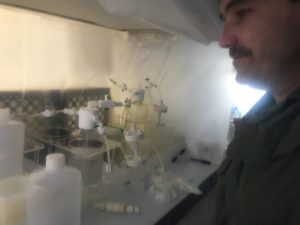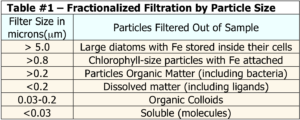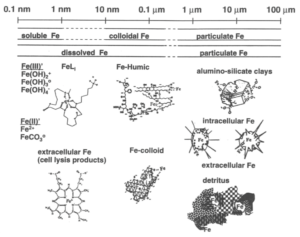Saturday, June 01, 2019 – On location and profiling for Incubation Site #2
PUPCYCLE Log: Day 09 – Micrometers, Nanometers, Picometers, Oh My!
Land Ho! The rocky steep cliffs of Big Sur, California appeared beneath a blanket of early morning fog as PUPCYCLE 2019 completed the last round of the water sample filtrations and prep work from Incubation Site #1 (Broad shelf region). In the final hours of today, the scientists will begin collecting samples from Incubation Site #2 (Narrow shelf). The continental shelf at our current

Matt Hurst (Humboldt State University) is analyzing concentration levels of iron found in the seawater at each incubation site. Matt’s experiment is measuring the concentration of iron collected during a relaxation phase and later comparing it to the concentration of  iron found in the samples after upwelling has been simulated with the incubation system. This comparison allows him to measure the amount of iron being taken up or used by diatoms and other forms of phytoplankton. Filtered samples will be compared across the various PUPCYCLE 2019 study parameters: water depth (surface @15m vs. deep @90m); shelf width (broad vs. narrow); and upwelling phase (relaxed vs. active). Matt uses a filtration system designed to separate the particles found in his sample into five groupings according to size. The filtration system Matt is using onboard the R/V Oceanus is similar to a soil sampling sieve used to separate soil particles by size between gravel (>2mm), sand (>0.05mm), silt (>0.002mm), and clay (<0.002mm). Based on the phytoplankton scale, displayed on Day 03: Sunday, May 26: The Phytoplankton Players, gravel falls within the size range of mesoplankton such as copepods and isopods, which can be seen with the naked eye.
iron found in the samples after upwelling has been simulated with the incubation system. This comparison allows him to measure the amount of iron being taken up or used by diatoms and other forms of phytoplankton. Filtered samples will be compared across the various PUPCYCLE 2019 study parameters: water depth (surface @15m vs. deep @90m); shelf width (broad vs. narrow); and upwelling phase (relaxed vs. active). Matt uses a filtration system designed to separate the particles found in his sample into five groupings according to size. The filtration system Matt is using onboard the R/V Oceanus is similar to a soil sampling sieve used to separate soil particles by size between gravel (>2mm), sand (>0.05mm), silt (>0.002mm), and clay (<0.002mm). Based on the phytoplankton scale, displayed on Day 03: Sunday, May 26: The Phytoplankton Players, gravel falls within the size range of mesoplankton such as copepods and isopods, which can be seen with the naked eye.

Matt Hurst was born in Southern California and completed his undergraduate degree in Chemistry at Humboldt State University. He completed his Ph.D. in Chemistry from the University of California at Santa Cruz before returning to Humboldt State University. The PUPCYCLE 2019 cruise marks Matt’s return to research at sea after 15 years.
Today’s Certificate Challenge: Using the Phytoplankton scale on Day 3: May 26 and Table #1 showing the filtration particle size (above), in which category of plankton would bacteria be classified?
